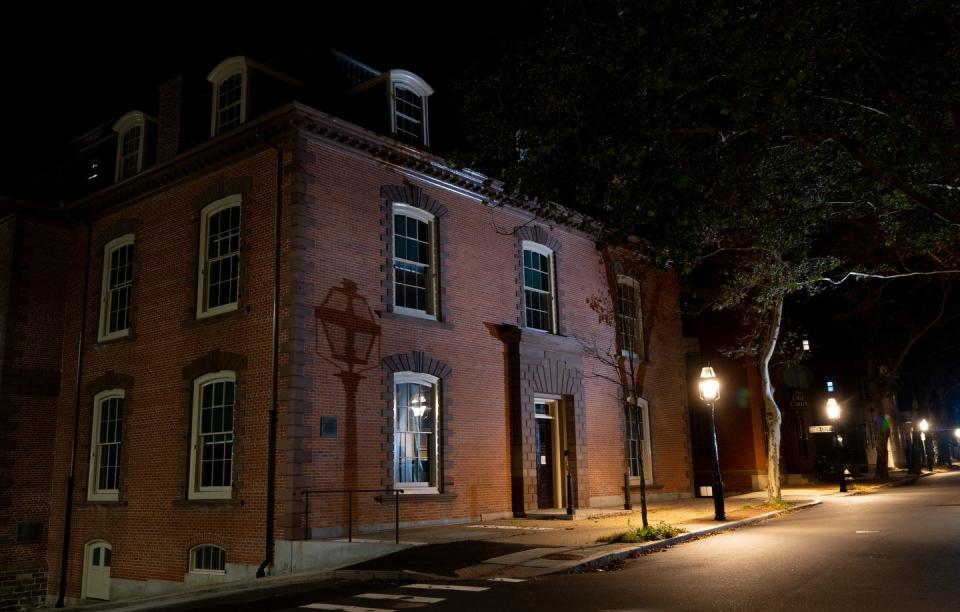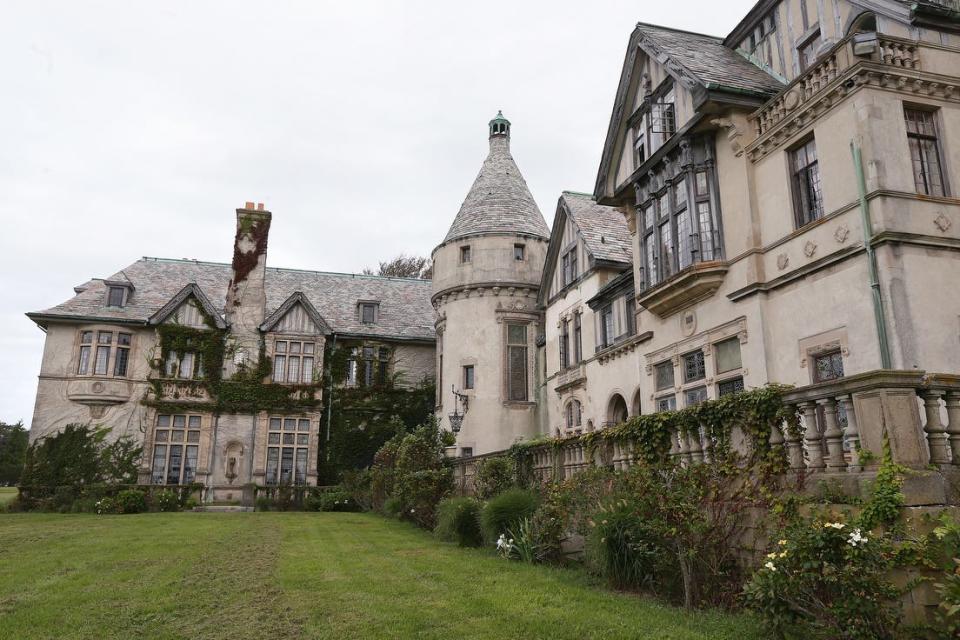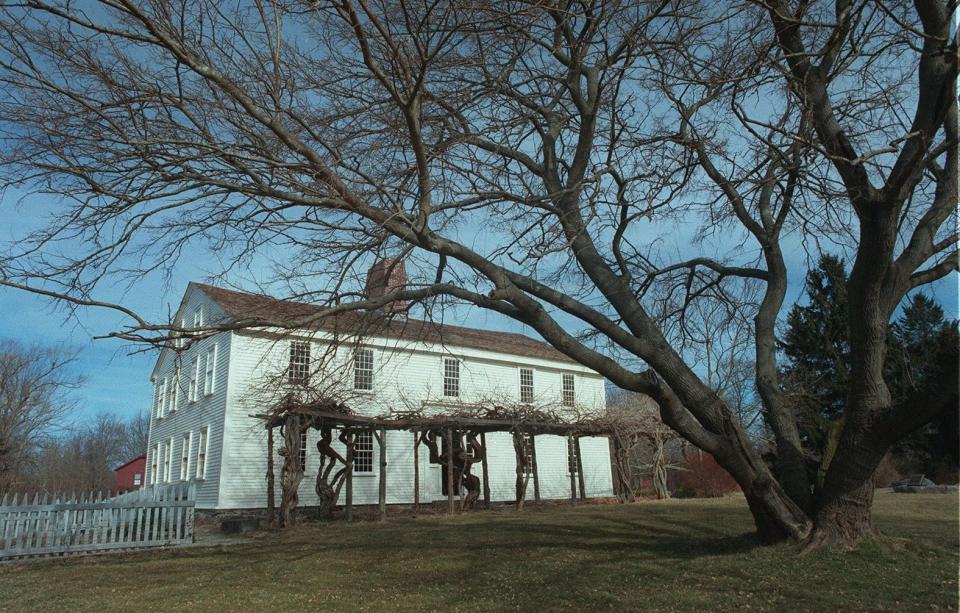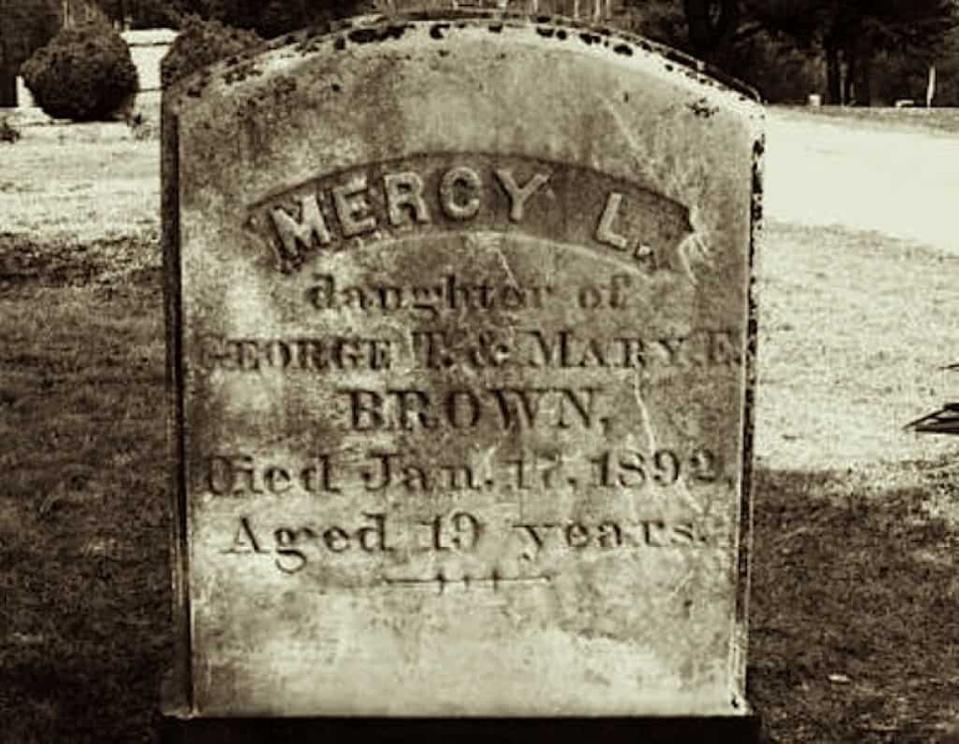Murders, vampire, mass grave: Here's the history and lore behind 5 of RI's haunted spots
- Oops!Something went wrong.Please try again later.
When the air gets a chill in the morning, the days shorten and the maples start dropping their leaves, the talk in New England turns to ghost stories.
Going all the way back to the first Colonists, people have mixed the historical truth with the paranormal to try to make sense of the world, or perhaps to deal with the guilt of a wrong. Ghosts have become a part of humble factories and mansions endowed with greater wealth than most can imagine.
Here are five stories, with roots in historical records, for you to read. Whether it’s ghosts or history that haunts these places, well, that’s for you to decide.

The Old State House in Providence: A miscarriage of justice
On April 8, 1844, the trial of John Gordon for the murder of Amasa Sprague began in the Old State House on Benefit Street in Providence.
A few months prior, on New Year’s Eve, Sprague’s body had been found in a ditch, beaten, shot and nibbled on by an animal. The murder of Sprague – brother of U.S. Sen. William Sprague III, a former governor of Rhode Island – sent a raw cry for vengeance through Providence.
This was back when the Irish were the dominant immigrant group coming to Rhode Island, shunned for perceptions around their drinking habits, their poverty and their Catholicism. When the posse of citizens investigating the crime became suspicious of Gordon, an Irish Catholic, anything could be turned into a clue to his guilt.
Footsteps in the snow that led to Gordon's house (and then kept going) and a discovered gun that may have been the one he lost (never proven), all spelled guilt.
During the trial, the judge told the jurors to give more credence to Yankee testimony than to Irish testimony. A prostitute, who worked for the brother of one of the judges presiding over the case, gave testimony that was later proven false by historians, that she had heard Gordon vowing to kill Sprague.
The trial lasted nine days. The jury deliberated for 75 minutes. Gordon was sentenced to death, an execution that was carried out on Feb. 14, 1845.
Rhode Island legends: Rebellion? Murders? Here are four of the most haunted restaurants in Rhode Island
Gordon was the last person ever to be executed in Rhode Island, and he was innocent. In 2011, he was officially pardoned.
In “Haunted Providence: Strange Tales from the Smallest State,” author Rory Raven tells the story of a worker at the Old State House building encountering a figure “in old-fashioned black clothes.” A woman who worked in the building reportedly told Raven that she believed it was the ghost of John Gordon, back to haunt the place where he had been wronged.
The Ramtail Factory in Foster: Death on the night shift
In the 1800s, Rhode Island was dotted with little factories and mill villages, and the way to get rich was to own one.
In 1813, Willam Potter, having moved from Warwick to a remote area in Foster, set out, with partners, to build the largest water-powered mill in the area, according to research by Thomas D’Agostino and Arlene Nicholson for their book “Rhode Island’s Haunted Ramtail Factory.” While the mill was officially known as the Foster Woolen Manufacturing Company, it came to be called Ramtail.
Potter’s daughter married Peleg Walker, who according to legend was ornery. D’Agostino pieced together documents that showed Walker bought a one-fourth share in the mill, as well as a stake in another mill in the area. Looking at his finances, D’Agostino concluded that Walker had likely outspent his income.
The legend is that Walker, who worked as the evening watchman at the mill walking around with a candle-lit lantern, predicted his death. He is said to have told his father-in-law in a fight that “one day you will have to take the keys to his mill from a dead man’s pocket.”
Rhode Island Legends: Did a ghost inhabit the Harborside Inn? Ghost tours, employees thought so
On Sunday, May 19, 1822, the prediction came true. Legend and D’Agostino’s research differ on exactly what happened. One says Walker hung himself from the bell’s rope, and the other has diary entries saying his throat was slit with a knife. He died hundreds of dollars in debt.
According to legend, one week later the villagers were awakened by the factory bell ringing at midnight, only to find no one inside. It happened again the next night and the next as well. After the bell was removed, the village was awakened again, this time by the sounds of the entire factory roaring to life in the dead of night.
The villagers started to leave, and in 1873, a fire burned the mill to the ground. A 1885 census report listed the place as haunted.
Today, the spot is a favorite of paranormal investigators, often featured on television shows and in articles. A swinging light is often seen and bells are sometimes heard, along with whispers. In one encounter D’Agostino and Nicholson had, they recorded Peleg saying he was killed, challenging the suicide explanation of his death that has become part of legend.
Only the ghosts know what really happened that night.
Seaview Terrace in Newport: Dark shadow over a whiskey baron's estate

Edson Bradley Jr. was good at making money and flaunting it.
The Connecticut native made his money as a whiskey baron, holding the exclusive rights to the Old Crow whiskey label. In 1907, he purchased a sprawling French-Gothic mansion in Washington, D.C.'s DuPont Circle, and decided that what it needed was to be bigger, with a ballroom, an art gallery, a home theater and a chapel. He worked with architect Howard Greenley to make that happen, shipping entire rooms that had been built in France across the Atlantic Ocean.
It was huge and grandiose, the perfect canvas for the ostentatious parties thrown by his socially ambitious wife, Julia. She was known for her American Beauty Ball, for which she would order so many roses that it caused a city-wide shortage, according to the Washington Chronicles.
Haunted places: Rhode Island can be pretty scary
The house was their winter home, but they soon had the thought so many Rhode Islanders can relate to, that their home would be better with an ocean view. And so, in 1923, they decided to move it, piece by piece, from Washington to Ruggles Avenue in Newport. It cost $2 million, which would be about $35 million today.
Only a few years after moving, Julie died in the mansion in 1929, her funeral held in the chapel shipped from Europe.
But it’s said that she liked the house so much that she’s never left. When the mansion became a girls school, there were reports of smoke detectors going off for no reason, bottles flying off desks and radios turning on and off by themselves. The mansion has been investigated on the show "Ghost Hunters."
From 1966 to 1971, Seaview Terrace was in the national spotlight when its exterior portrayed the fictional Collinwood mansion in ABC's hit vampire soap opera "Dark Shadows."
Smith’s Castle in North Kingstown: Slave plantation, and site of a mass grave

In 1637, Richard Smith erected the first English-style house in Cocumscussoc. The house was a daunting sight against the landscape and was thought to be fortified, making it a castle in the eyes of locals, even if it would be considered a plain Colonial today.
When Smith’s son, Richard Smith Jr., took over the house after his father’s death in 1666, he started to transform Smith’s castle from a trading post into a plantation, lured by the idea of greater profits. It’s not known, according to Smith’s Castle's slave medallion research, exactly how many slaves were there at any given time, but at least nine people were held in bondage there. It is one of the oldest surviving plantation houses in America.
As Smith’s Castle changed from trading post to plantation, the atmosphere around the house changed as well. The early settlements in that area were the result of the so-called Pettaquamscutt Purchase, a tract of fertile land purchased from the Narragansett Tribe. But as there was money to be made, the land attracted all sorts of disputes, creating conflict between businesses from Rhode Island, Connecticut and Massachusetts and the Narragansett tribe. For years the tensions simmered.
In 1675, it snapped. As tribes felt the continued unfairness of Colonists trampling their rights, King Philip’s War broke out. The first major fight of the war was the Great Swamp Massacre on Dec. 19, 1675, just 12 miles away from Smith’s Castle. The fight was “essentially a slaughter of the Narragansetts and the Wampanoag refugees among them. The Indians were betrayed by one of their own people who led 1,100 soldiers from Massachusetts, Connecticut and Plymouth through a secret path to an unfortified section of the Indian encampment,” it reads in “Rhode Island: A History.”
What and Why RI: Kingston used to be known as 'Little Rest.' These are the stories behind the original name
The Colonists set fire to the Narragansetts' winter encampment, burning women and children, while mercilessly fighting the Natives until a snowstorm ended the massacre.
On their way back to Aquidneck Island, the Colonists stopped at Smith's Castle. There, they buried 40 Colonial soldiers in a mass grave.
The next year, in retaliation for the attack, Smith's Castle was burned, to be rebuilt two years later.
There’s a belief that in places where something truly awful happens, the tragedy leaves a mark. At Smith’s Castle, there are reports of ghosts in Colonial attire and of slaves who died in the escape tunnels under the house, in the book “Haunted Rhode Island.” For years, the Rhode Island Society for the Examination of Unusual Phenomena (RISEUP) held paranormal investigations that were open to the public, who reported doors unlatching themselves, hearing voices and other unexplained activity.
Mercy Brown's grave in Exeter: Resting place of a vampire?

In March 1892, the villagers in Exeter were looking for answers.
Edwin Brown was sick with tuberculosis, and nothing was working. In desperation, he had traveled all the way to Colorado Springs, Colorado, hoping the waters would heal him. But he came back still coughing blood, and then found that his 19-year-old sister, Mercy Lena Brown, had succumbed to the same disease and was lying in a coffin, waiting for the ground to thaw so she could be buried with her mother and older sister, who had also died of consumption years before.
Edwin could barely breathe, and no one had a scientific explanation for why a once-healthy young man would be dying.
But they had a belief.
Go see: How to visit 'Conjuring' house and other haunted Rhode Island spots
Between 1784 and 1800, tuberculosis killed 2% of the entire New England population and people were desperate to understand why their loved ones were dying. To do so, they turned to a creature from the Old World, vampires, who were bloody and pale like the people they were watching die. They believed the deaths were the work of departed loved ones who were returning from the grave to feed on the life force of family members.
Mercy, the villagers believed, was sucking the life out of her brother.
The family's patriarch, George Brown, didn't believe in vampires. But death had knocked on his door so many times that when the townspeople came to him wanting to exhume the graves of his family members to see if one of them was responsible for Edwin's sickness, he let them.
His wife and eldest daughters were ruled not to be vampires, but Mercy looked almost the same as she had when she died in January. They were shocked that her hair and nails had grown and that she was still full of blood, and they took that as confirmation: She was a vampire.
They ripped out her heart. They cut out her lungs.
They burned them, took the ashes and mixed them with water to give to Edwin as a tonic to cure him. Consuming his sister's ashes did not cure him, and he died two months later.
Mercy was reburied – sans her heart – in the cemetery at the Chestnut Hill Baptist Church. Perhaps because of the way her remains were treated, she's said to haunt the cemetery, with reports of a strange blue light sometimes seen hovering above the stone.
This article originally appeared on The Providence Journal: Haunted RI: The folklore and history behind 5 of RI's spookiest places

